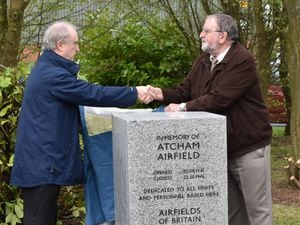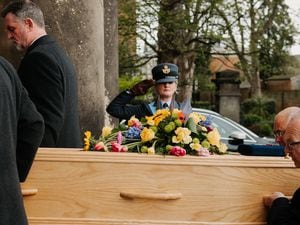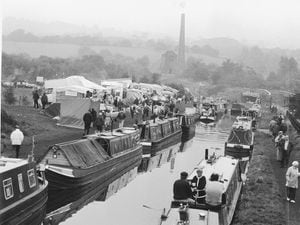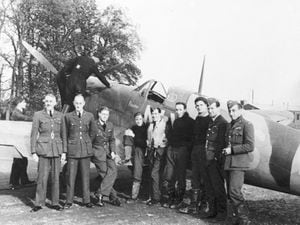Double medal mystery of Shropshire VC hero
On display at Shropshire Regimental Museum are the two Victoria Cross medals of Oswestry war hero Harold Whitfield.
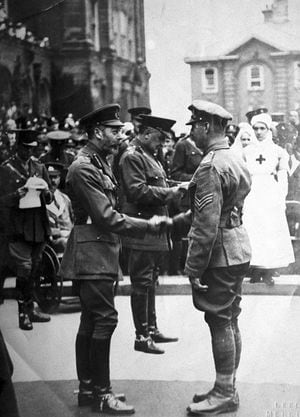
One, the real deal, was won in the heat of battle 100 years ago and presented to him in person by the King. In the 1970s it was stolen from an Oswestry bank vault, but quickly recovered.
The other is a good quality replica found lying in a London street a few years ago.
How did it come to be there? How come there are two medals? It is a story which is curious, intriguing, mysterious and, for the moment at least, unresolved.
Whitfield's heroism was remembered with a centenary ceremony in Oswestry in May this year in which a commemorative paving stone in his honour was officially unveiled in Cae Glas park.
Among those present were members of his family, including his 84-year-old daughter Dorothy.
Private Whitfield - he was later promoted Sergeant - won the VC while serving in the 10th Battalion of the King's Shropshire Light Infantry for an action in March 1918 against the Turks.
It was presented by King George V in Leeds and Whitfield was feted as a hero when he came home to Oswestry.
He died in 1956 after being knocked off his bicycle by an Army vehicle while cycling home from work at Express Dairies in Whittington. His VC was put for safe keeping in the vault of Midland Bank in Oswestry, but in 1976 was stolen by a 21-year-old bank clerk.
Happily the medal was recovered when the culprit tried to sell it to a dealer in London.
That was the real medal, which in 2000 was presented by the family to the regimental museum at Shrewsbury Castle.
Now we turn to the strange story of the replica, found in London not long ago by Simon Jepheart, the part owner of a lift firm based in Swanley, Kent.
"I found it on the Clerkenwell Road," said Simon.
"We do the lifts for the Barbican centre and I was walking there with a lift engineer and we saw a box on the pavement. I picked it up and looked inside and there was what I assumed was a Victoria Cross," he recalled.
He took it to the police, but they said there was nothing they could do, leaving it to Simon to track down the original owner. Seeing Whitfield's name with the medal, he researched on the internet and made the Shropshire connection, and then contacted Shropshire Regimental Museum.
"They contacted the family of Mr Whitfield and they were not missing a medal. The museum said it had the original and thought what I had was probably a dress medal, one the soldier would wear if they didn't want to wear the original out on parade - that's what I seem to have found.
"I put it in a cupboard for a while. It's a beautiful medal. I wondered what to do with it. I thought it didn't belong to me, and sent it off to the curator, and that's the last I really heard of it," said Simon, of Guideline Lift Services.
Simon added: "It's just something that bemused me, that someone has lost it but nobody has claimed it. If I had lost that I would be beside myself, as most people would."
That replica found by Simon is now part of Harold Whitfield's display cabinet at the museum, and the display note with it says that it was "recently found at the bottom of a lift shaft in London."
Although a check of museum records confirms that that was indeed the information given in 2010 correspondence when the medal was donated - that it was "found in the lift shaft pit area of the Barbican arts centre" - Simon says that information is not correct and he definitely found it on the pavement in Clerkenwell Road.
Peter Duckers, acting curator of the museum, said it was a nice gift from Mr Jepheart.
To the untrained eye, the replica in its handsome box is a convincing copy, but it does have an incorrect date on the back. The reason is a matter of conjecture - could it have been a simple error, or could it have perhaps been done deliberately to signal that this was not Whitfield's original VC as a way of stopping the two getting mixed up?
One theory that does not hold water is that the replica was an officially sanctioned replacement from Hancocks in London - sole supplier of Victoria Crosses - for when the original was stolen in 1976.
However Mr Duckers says that a special test on the metal has shown that it is not an original, official, Victoria Cross.
"It is in a Hancocks box but was not made by Hancocks."
A possibility is that it was made as a replica for a member of Harold Whitfield's family, although Mr Duckers says that when he spoke at the time to John Whitfield, Harold Whitfield's son, who has since died, he had no knowledge of one ever being made for a family member.
"He said that strangely enough a number of years ago he had a phone call from a chap who said he had a Whitfield Victoria Cross in a Hancocks box, who would not give details.
"He said could I meet you in the Oswestry park and show it to you and you can give your opinion on it. He actually went out to Oswestry park and sat there for four hours and nobody turned up and he never heard anything more about it."


